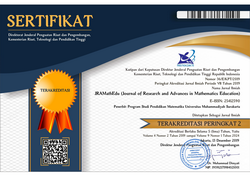Exploring senior high school student's abilities in mathematical problem posing
Muhtarom Muhtarom(1*), Ali Shodiqin(2), Novita Astriani(3)(1) Department of Mathematics Education, Universitas PGRI Semarang
(2) Department of Mathematics Education, Universitas PGRI Semarang
(3) Department of Mathematics Education, Universitas PGRI Semarang
(*) Corresponding Author
Abstract
The ability of problem posing is very essential for the student’s. However, there are still many students who don't realize the importance of these abilities. This research describes the senior high school student’s ability in mathematical problem posing, especially in the material system of linear equations in three variables. Research data were collected from 7 student’s using written test and interview techniques. The validity of the data used triangulation methods by comparing the results of written tests and interviews. Data were coded, simplified, presented, and triangulated for the credibility and conclusion drawing. The results show that there were still very few students who have all three classifications of problem posing abilities, namely pre-solution posing, within-solution posing, and post-solution posing. Students who have the ability of pre-solution posing can ask questions based on the data provided and can arrange problem solving. Students who have the ability of within-solution posing can write what is given and asked of the problem, raise supporting questions which is relevant to the problem and arrange solutions to the supporting questions and problems that are given correctly. Students who have the ability of post-solution posing can raise similar mathematics problem after solving the problem. Students can also arrange solutions to problems that have been made. Teacher needs to practice pre-solution posing, within-solution posing, and post-solution posing to the students.
Keywords
Full Text:
PDFReferences
Arikan, E. E., & Ünal, H. (2015). Investigation of problem-solving and problem-posing abilities of seventh-grade students. Educational Sciences: Theory and Practice, 15(5), 1403-1416. Retrieved from https://files.eric.ed.gov/fulltext/EJ1101279.pdf
Arofah, D. N., & Masriyah. (2019). Profil pengajuan masalah matematika siswa SMP ditinjau dari gaya kognitif reflektif dan impulsif. MATHEdunesa, 8(2), 209–215. Retrieved from https://jurnalmahasiswa.unesa.ac.id/index.php/mathedunesa/article/view/27975/25597
Ayllón, M. F., Gomez, I. A., & Ballesta-Claver, J. (2016). Mathematical thinking and creativity through mathematical problem posing and solving. Journal of Educational Psychology-Propósitosy Representaciones, 4(1), 195–218. https://doi.org/10.20511/pyr2016.v4n1.89
Barlow, A. T., & Cates, J. M. (2006). The impact of problem posing on elementary teachers’ beliefs about mathematics and mathematics teaching. School Science and Mathematics, 106(2), 64–73. https://doi.org/10.1111/j.1949-8594.2006.tb18136.x
English, L. D. (1997). Promoting a problem-posing classroom. Teaching Children Mathematics, 4(3), 172-179. Retrieved From https://search.proquest.com/ openview/cdd66cae97b9482d93b4bb9e0cb35487/1?pq-origsite=gscholar&cbl =32876
Ghasempour, Z., Bakar, N., & Jahanshahloo, G. R. (2013). Innovation in teaching and learning through problem posing tasks and metacognitive strategies. International Journal of Pedagogical Innovations, 1(1), 53–62. Retrieved from https://platform.almanhal.com/Files/2/46793
Mahmudi, A. (2011). Problem posing untuk menilai hasil belajar matematika. Seminar Nasional Matematika Dan Pendidikan Matematika Matematika Dan Pendidikan Karakter Dalam Pembelajaran. Retrieved from http://eprints.uny.ac.id/7359/1/p-3.pdf
Miles, M. B., & Huberman, A. M. (2002). The qualitative researcher’s companion. California: Sage publications.
Moleong, J. L. (2008). Metodologi penulisan kualitatif, edisi revisi. Bandung: Remaja Rosdakarya.
Murtianto, Y. H., Muhtarom, M., Nizaruddin, N., & Suryaningsih, S. (2019). Exploring student’s productive thinking in solving algebra problem. TEM Journal - Technology, Education, Management, Informatics, 8(4), 1392–1397. https://doi.org/10.18421/TEM84-41
Rachmawati, Y. I., Sugandi, E., & Prayitno, L. L. (2019). Senior high school students’ ability in posing system of linear equations in two variables problems. JRAMathEdu (Journal of Research and Advances in Mathematics Education), 4(1), 57–65. https://doi.org/10.23917/jramathedu.v1i1.6954
Rosli, R., Capraro, M. M., & Capraro, R. M. (2014). The Effects of problem posing on student mathematical learning: a meta-analysis. International Education Studies, 7(13), 227–241. https://doi.org/10.5539/ies.v7n13p227
Rosli, R., Goldsby, D., & Capraro, M. M. (2013). Assessing students’ mathematical problem-solving and problem-posing skills. Asian Social Science, 9(16), 54–60. https://doi.org/10.5539/ass.v9n16p54
Silver, E. A. (1994). On mathematical problem posing. For the learning of mathematics. 14(1), 19–28. Retrieved from https://www.jstor.org/stable/40248099
Silver, E., & Cai, J. (1996). An analysis of arithmetic problem posing by middle school students. Journal for Research in Mathematics Education, 27(5), 521–539. https://doi.org/10.2307/749846
Siswono, T. Y. E. (2011). Level of student’s creative thinking in classroom mathematics. Educational Research and Reviews, 6(7), 548–553. Retrieved from http://www.academicjournals.org/ERR
Stoyanova, E. (2005). Problem-problem strategies used by years 8 and 9 students. AAMT Standards for Excellence in Teaching Mathematics in Australian Schools, 61(3), 6–11. Retrieved from https://files.eric.ed.gov/fulltext/EJ743563.pdf
Tuğrul, K. (2010). The relation between problem posing and problem solving skills of prospective elementary mathematics teachers. Procedia Social and Behavioral Sciences, 27(5), 521–539. https://doi.org/10.1016/j.sbspro.2010.03.239
Xia, X., Lu, C., & Wang, B. (2008). Research on mathematics instruction experiment based on problem posing. Journal of Mathematics Education, 1(1), 153-163. Retrieved from https://pdfs.semanticscholar.org/581a/4a00a72e81a5326fb58c72c681129050adf.pdf
Xie, J., & Masingila, J. O. (2017). Examining interactions between problem posing and problem solving with prospective primary teachers: A case of using fractions. Educational Studies in Mathematics, 96(1), 101–118. https://doi.org/10.1007/s10649-017-9760-9
Article Metrics
Abstract view(s): 761 time(s)PDF: 559 time(s)
Refbacks
- There are currently no refbacks.








